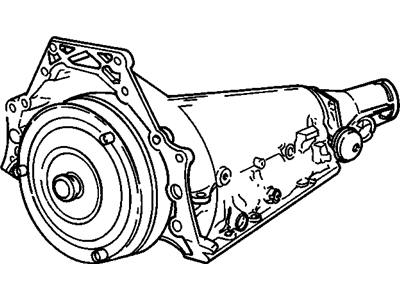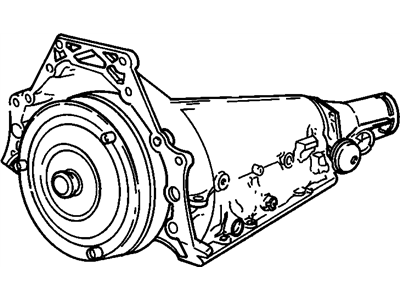My Garage
My Account
Cart
Genuine GMC Safari Transmission Assembly
Trans Assembly- Select Vehicle by Model
- Select Vehicle by VIN
Select Vehicle by Model
orMake
Model
Year
Select Vehicle by VIN
For the most accurate results, select vehicle by your VIN (Vehicle Identification Number).
31 Transmission Assemblies found
GMC Safari Transmission,Auto(Goodwrench Remanufacture)
Part Number: 24216088$2371.94 MSRP: $2674.88You Save: $302.94 (12%)GMC Safari Transmission Asm,Auto (4Mjd) (Remanufactured)
Part Number: 8688973$2254.56 MSRP: $2542.09You Save: $287.53 (12%)Ships in 1-3 Business DaysGMC Safari Transmission Asm,Auto (Remanufactured)
Part Number: 8691927$2254.56 MSRP: $2542.09You Save: $287.53 (12%)Ships in 1-3 Business DaysGMC Safari Transmission Asm,Auto (3Tad) (Goodwrench Remanufacture)
Part Number: 24229167$2836.96 MSRP: $3192.60You Save: $355.64 (12%)Ships in 1-3 Business DaysGMC Safari Transmission Asm,Auto (4Msd) (Remanufactured)
Part Number: 8688975$2254.56 MSRP: $2542.09You Save: $287.53 (12%)Ships in 1-3 Business DaysGMC Safari Transmission Asm,Auto (Remanufactured)
Part Number: 24201021$2316.69 MSRP: $2612.38You Save: $295.69 (12%)Ships in 1-3 Business DaysGMC Safari Transmission Asm,Auto (Remanufactured)
Part Number: 8691928$2316.69 MSRP: $2612.38You Save: $295.69 (12%)Ships in 1-3 Business DaysGMC Safari Transmission Asm,Auto (3Msd) (Goodwrench Remanufacture)
Part Number: 24229168$2317.16 MSRP: $2604.59You Save: $287.43 (12%)Ships in 1-3 Business Days
| Page 1 of 2 |Next >
1-20 of 31 Results
GMC Safari Transmission Assembly
Each OEM GMC Safari Transmission Assembly we offer is competitively priced and comes with the assurance of the manufacturer's warranty for the part. Furthermore, we guarantee the speedy delivery of your orders right to your doorstep. Our hassle-free return policy is also in place for your peace of mind.
GMC Safari Transmission Assembly Parts Questions & Experts Answers
- Q: How do you remove and install a automatic transmission on GMC Safari?A: To remove the transmission, start by disconnecting the negative battery cable and removing the engine cover and transmission fluid dipstick. On carbureted and TBI engines, remove the air cleaner assembly. Raise the vehicle, support it securely on jackstands, and drain the transmission fluid before reinstalling the pan. On 700-R4 and older 4L60 models, disconnect the TV cable and plug the hole. On 1995 and earlier models, disconnect the shift linkage, and on 1996 and later models, disconnect the Shift Cable. If equipped, disconnect the speedometer cable. Label and disconnect all electrical harness connectors from the transmission and remove the driveshaft and any exhaust components that may interfere with transmission removal. Remove the engine-to-transmission struts or transmission braces if present. Remove the converter housing lower cover to access the torque converter-to-drive plate bolts. Match-mark the driveplate to the torque converter and remove the torque converter bolts. Position a transmission jack under the transmission, unbolt the transmission mount, remove the crossmember and angular brackets, and lower the transmission to gain access to other components. Remove the transmission-to-engine bolts, dipstick tube, and disconnect the transmission cooler lines. If equipped, remove the transmission damper and support. Support the engine with a floor jack, remove the starter motor, and ensure all wires and cables are disconnected from the transmission. Separate the transmission from the engine while holding the torque converter back against the transmission. For installation, ensure the torque converter is seated correctly, raise the transmission into position and push it forward onto the locating pins. Install the drive plate-to-converter bolts, aligning the marks made during removal, and tighten them to specified torque. Install a new oil filler tube O-ring and then install the various components in reverse order. Adjust the shift linkage, throttle valve cable, or shift cable as needed. For 1996 and later models, use new spring clips to secure the cooler lines at the radiator, ensuring they are properly mated and secure. If the transmission has been drained, follow a specific fluid filling procedure to ensure the correct fluid level. Add approximately 5-1/2 quarts of transmission fluid through the filler tube, start the engine, move the shifter through each range, and check the fluid level with the shifter in Park while the engine is running. Add fluid gradually to bring it between the two marks on the dipstick, preventing overfilling.
Related GMC Safari Parts
Browse by Year
2005 Transmission Assembly 2004 Transmission Assembly 2003 Transmission Assembly 2002 Transmission Assembly 2001 Transmission Assembly 2000 Transmission Assembly 1999 Transmission Assembly 1998 Transmission Assembly 1997 Transmission Assembly 1996 Transmission Assembly 1995 Transmission Assembly 1994 Transmission Assembly 1993 Transmission Assembly 1992 Transmission Assembly 1991 Transmission Assembly 1990 Transmission Assembly 1989 Transmission Assembly 1988 Transmission Assembly 1987 Transmission Assembly 1986 Transmission Assembly 1985 Transmission Assembly









